Voyage of Tuffy: Starting for Home
Only three days outside the Park now, starting the long road home
Article series by John Hughes
Only three days outside the Park now, starting the long road home. I’m writing again so soon for a couple of reasons; Three really cool Alaskan towns to tell you about, and I’ve actually got internet here and can send it and some pictures off to Josh!
A very cool captain of the Ocean Ripple, a huge aluminum purse seiner, gave me the password for his StarLink because I helped a Grand Banks negotiate moving over to our side of the dock, facilitating the captain pulling in… more on that later.
We’ve conjured up a plan to be in Wrangle for the 4th of July, with a laundry stop in Petersburg in route, but we’ll see what happens.
As we left the Park Headquarters dock I called in on channel 12 to report our departure past the fuel dock in Bartlett Cove (they like that), and as we started into the channel I hit the Motorola talk button, “Bob, that looks a lot like fog!” This is Bob’s 4th trip up the Passage.
“Yup”, came the reply.
“What do you think?”, says I
“Thick”, says he. I hugged a little closer to Snow Goose and we followed the lines laid out for Whale Preservation compliance on our charts, throttled back a little more than normal. Very soon I hear, “Bartlett Cove, this is Puffin do you copy?” Sam Devlin, the designer and builder of Tuffy was crossing the park entrance. I hopped on 16 a few minutes later to hail Sam. “Puffin, Puffin, this is Tuffy, do you copy?”
A bit later, “Tuffy, this is Puffin, over.” “Go to 68, Sam?” “Roger that.” After laughing about our “ships in the night” experiences coming up the Passage, culminating in this foggy channel passing, I asked if the fog was out there in Icy Straits too? “All the way across” Sam replied. After sending our mutual wishes for safe travels we signed off and we never did see Puffin materialize out of that fog. I’m certain Tuffy could feel her builder close though. Icy Straits was covered in a low fog, so we stayed close and followed our plotted course carefully, horn in hand. Visibility was probably 50 to 100 yards at worst so I felt ok about responding to any shape materializing out of the whips, and about three quarters of the way across the fog started to thin. By the time we approached the shore it had lifted completely and so far that’s been our only encounter. Yesterday I took advantage of the clear weather and played around with my radar to reacquaint myself with its operation and to see what various boats, islands, and points looked like on its old black and white screen. Now I’m better prepared for the next batch of fog.
Your first sight as you approach Hoonah is the cruise ships docked and anchored just off Icy Straits… but then you go around the corner and into the real community—a friendly local town operated principally by Lingit peoples. The Lingit (see sidebar) were smart to build an amazing playground for the cruise shippers, and build it around the point from town. A couple of gondolas carry people up the surrounding mountains and a zip-line set-up brings them, squeeling all the way back down. A plethora of shops and a multitude of restaurants keep the cruisers into beer, burgers and trinkets. Some of the more adventurous do stray into town, but the impact is much less than where the ships to literally tie to downtown docks. We did the reverse pilgrimage, busing out to see what they have created out there and then walked the beautiful shoreline path a couple of miles back to town. Hoonah is surrounded by magnificent hills and coves, and has some great folks with a lot of history, but like so many Alaskan towns it has been overtaken by the cruise ship industry… good for the Linget people to handle it in a creative and functional manner, and to be able to build an economy around it and improve their lives and opportunities… but when multiple ships, carrying thousands of people each, simultaneously come into a town of just over 900, the impact is felt.
SIDEBAR
We took in a ceremonial dance performance and learned an interesting fact: The indigenous people of the Pacific Northwest are the Lingit people. They pronounce their “L” with a tongue to the roof of the mouth “t” sound. The government struggled with this, so decided to add the “T,” making the “Lingit” People now the “Tlingit” People. They prefer to be referred to by their real name, which I will do hence forth in writing about while still struggling to pronounce the “L” with a hint of a “T.”
The following day we motored back out into Icy Straits, and then south into Chatham Strait with Tenakee Springs our destination. Chatham Strait is another large body of water in the Passage domain and can get quite rough. On this day it was tame as could be as we traveled to Tenakee Springs—another small community where everybody and everything comes in by boat or sea plane. Chatham Strait is full of marine life with dolphins, seals, otters and humpbacks in abundance. I believe the cold water exiting Glacier National Park, the deep canyons that lie under the surface, the strong riptides, the upwellings caused by such strong tides and the proximity to the ocean all work together to make these waters especially nutritious and life supportive. Yet, even with all this extraordinary activity going on around us, it still felt at times as if we were the only two boaters in Alaska. Just an occasional commercial vessel making its way by, or a big pleasure yacht (maybe with a helicopter pad up top) working its way up or down the Admiralty Island shore.
We continued south and then west into the Inlet, pulling into a small Tenakee Springs marina in time to find a couple of side-tie spaces. One dirt road follows the rocky shore with houses on both sides (on stilts on the one side and carved into the hill on the other) and an occasional tire-marked driveway heading up somewhere into bear country. The residents, all 100-150 of them, buzz around in their ATVs, living a very linear town existence. The one grocery store had a sign on it that said, “Closed for a week or two, don’t panic!” There’s a post office, an airport (which consists of a dock for sea planes, which we did see delivering the mail and Amazon packages—probably not overnight though), and a public bathroom that defies description (see photo). The local coffee and snack house is always open and signage indicates you should feel free to brew up your coffee or tea, have a snack from the rack and to please put an appropriate amount of money in the money jar. Back at the harbor the local kids were jumping off the dock ramp (into what had to be 40 degree water) and casting their fishing lines into the water, laughing all the while. There are probably worst places to grow up than Tenakee Springs, at least in the summer.
Another long day (53 miles) continuing down the Baranof Island side of Chatham Strait brought us to our next, even smaller township. Dolphins and humpbacks were making the scene all day and the whole shoreline was being fished by purse seiners, a motherboat laden with posts, poles, gears and shackles, that sends out its tender with one end of the net to circle around an area, and then the huge equipment begins to whir and crank and clatter to haul it all in.
There was a seiner, its tender, and its net in some stage of this operation, and then another seiner/tender/net right next to it side-by-side all the way down the shoreline. When we would come to a bay, or a small archipelago of islands where multiple rivers found their way from mountain to sea, there would be dozens of seiners, all lined up, with the next one in line swooping in behind the previous one as its tender closed off the loop and the gears starting spinning. They were operating from deep within these bays on out into the strait outside them, and I can’t imagine how there can be any fish left in there to catch. Successfully managing to find a navigable route through them without getting Tuffy hauled into a net, we left the strait to enter into Warm Springs Cove, home of Baranof Hot Springs, a community that makes Tenakee Springs seem a booming metropolis (this one lacks even one road).
A massive waterfall cascades into the cove from a river raging down from Baranof Lake above the bay. Alongside this waterfall, and wrapping around the bay, are a series of boardwalks, serving as pedestrian streets—for there are no roads. A building along one such boardwalk has a sign denoting it the Soaking House, in which there are three individual rooms, with large two-person tubs in each one, an open wall to the bay (draw the curtains if it’s stormy) and hot and cold water hoses (with faucets) plumbed into each tub allowing the bather(s) to adjust the temperature just so. Pipes of course run to all the houses in town, which is actually a borough of the city of Sitka and has about fifteen seasonal homes. Population is probably about 30 now during the summer, but drops to one in the winter—the guy with the snowblower backed up to his front door. He clears a boardwalk path down to the dock to keep it free of glaciating and sinking.
The bath at the Soaking House was every bit as pleasurable as you might expect. I keep my hot tub at home at 104 in the summer, 105 sometimes in the winter so I didn’t need to mess with the coldwater faucet. I did sneak a glass of wine in there and just let the muscles go as I looked out at a snow-covered hill above a waterfall cascading into an idyllic cove with Tuffy securely tied to a stout dock. Only hunger could stir those heated muscles into action, so it was back to the boat, relaxed beyond description. The Seiners started coming in—evidently they are so prolific at catching salmon that they’re allowed to operate only two days a week this season, on Thursdays and Sundays, and today was the first day of the season. We shuffled boats around on the dock and soon the few private cruisers here were on the inside of the dock and dwarfed by these big guys rafted out two and three deep on the outside. That beautiful waterfall creates a tremendous current and its great sport to watch he skippers coming into a small space under heavy throttle and pulling a Captain Ron style docking.
The source of the spring itself is up a path, mostly fitted with boardwalks (of a fashion), to the lake a mile or so uphill from town (bring your bear spray) and there several more natural pools have been constructed by building rock dams. The whole set up overlooks a raging river, cascading noisily through a granite canyon, ultimately feeding the waterfall that shoots into the bay. The top pool is hot! —probably 110 degrees—but the lower one is maybe 105/106 degrees, which is manageable for a limited time (with with no cold water faucet to temper them, the only adjustment is the amount of time spent in them). After soaking for about 10-15 minutes in the lower pool, Bob and I walked on up to the lake, which is quite large (with canoes hanging from trees and rowboats stashed in the bushes) and signs indicating there are trout, even cutthroat trout, of which you are allowed two per day.
These three towns have made me contemplate turning west to Sitka but we’ve targeted a return to our homeports by the end of July, so our plan is to leave in the morning, anchor in an unnamed cove by Kake—one that Bob discovered on a previous trip and where, he assures me, he can introduce me to a bear. Then we’ll motor back to Petersburg as mentioned, before visiting Wrangell for our first time to hang there to celebrate America’s birthday! So for now, one more dinner in Baranof Hot Springs, one more soak today during that long twilight, early to bed and early to rise (for one more soak tomorrow dawn’s twilight) and then, crossing of Chatham Strait to meet a bear.
The weather continues to be warmer, drier, and less windy than usual, which is doing a fine job of making up for earlier in the trip when it was colder, wetter and windier than usual. See you again with a few more miles under the keel. •SCA•

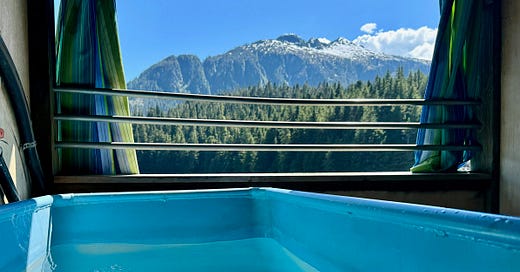

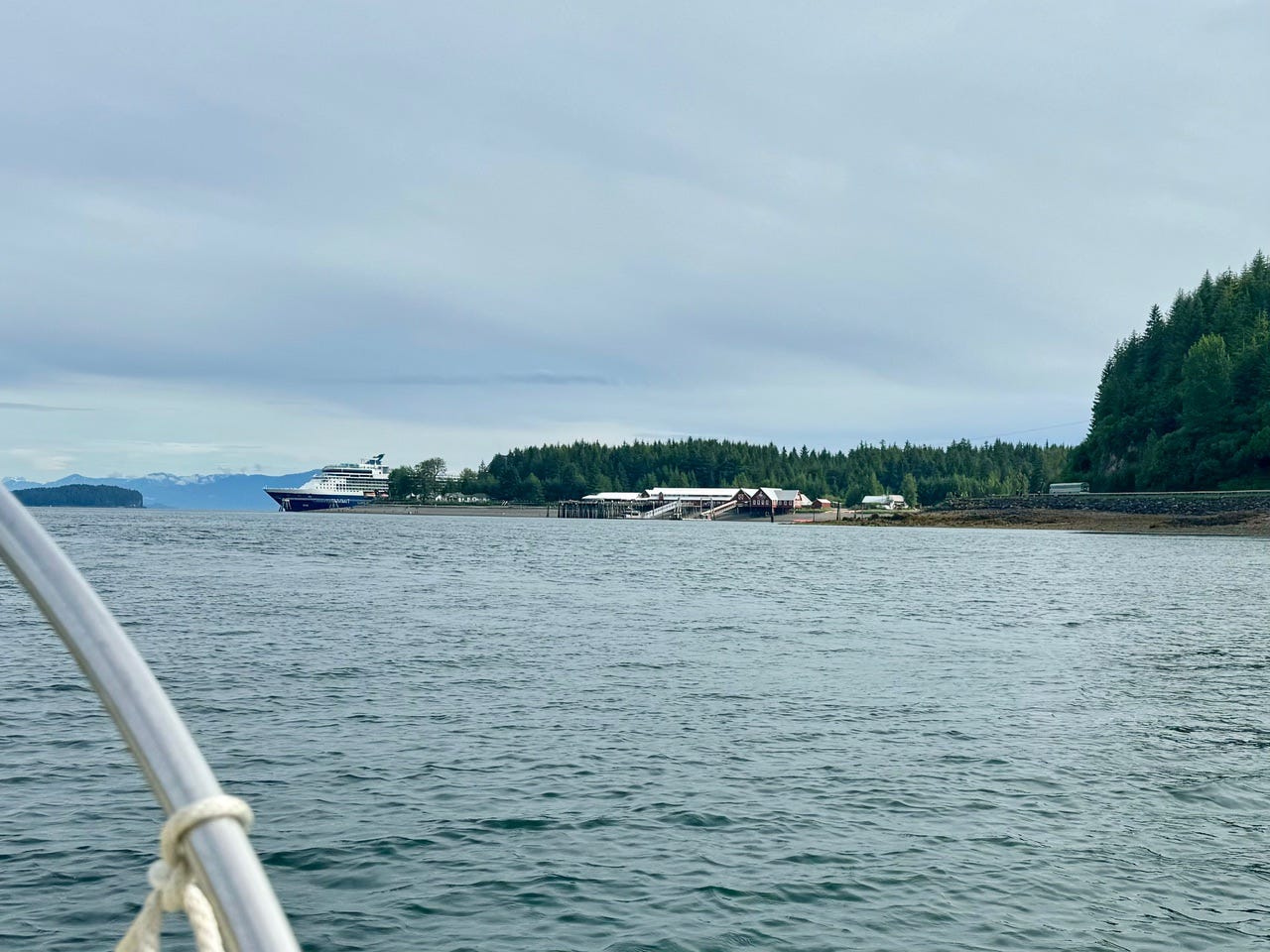
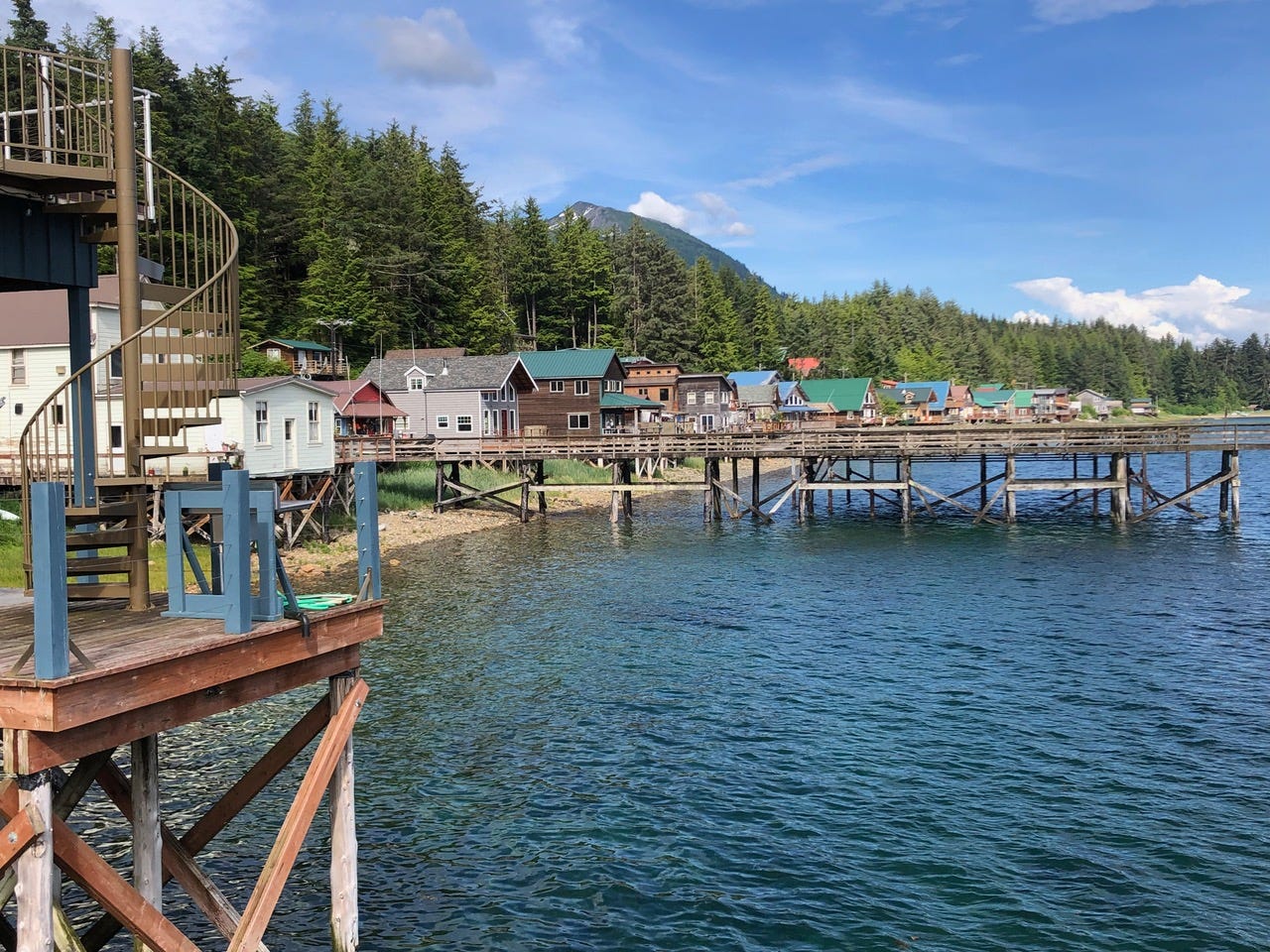
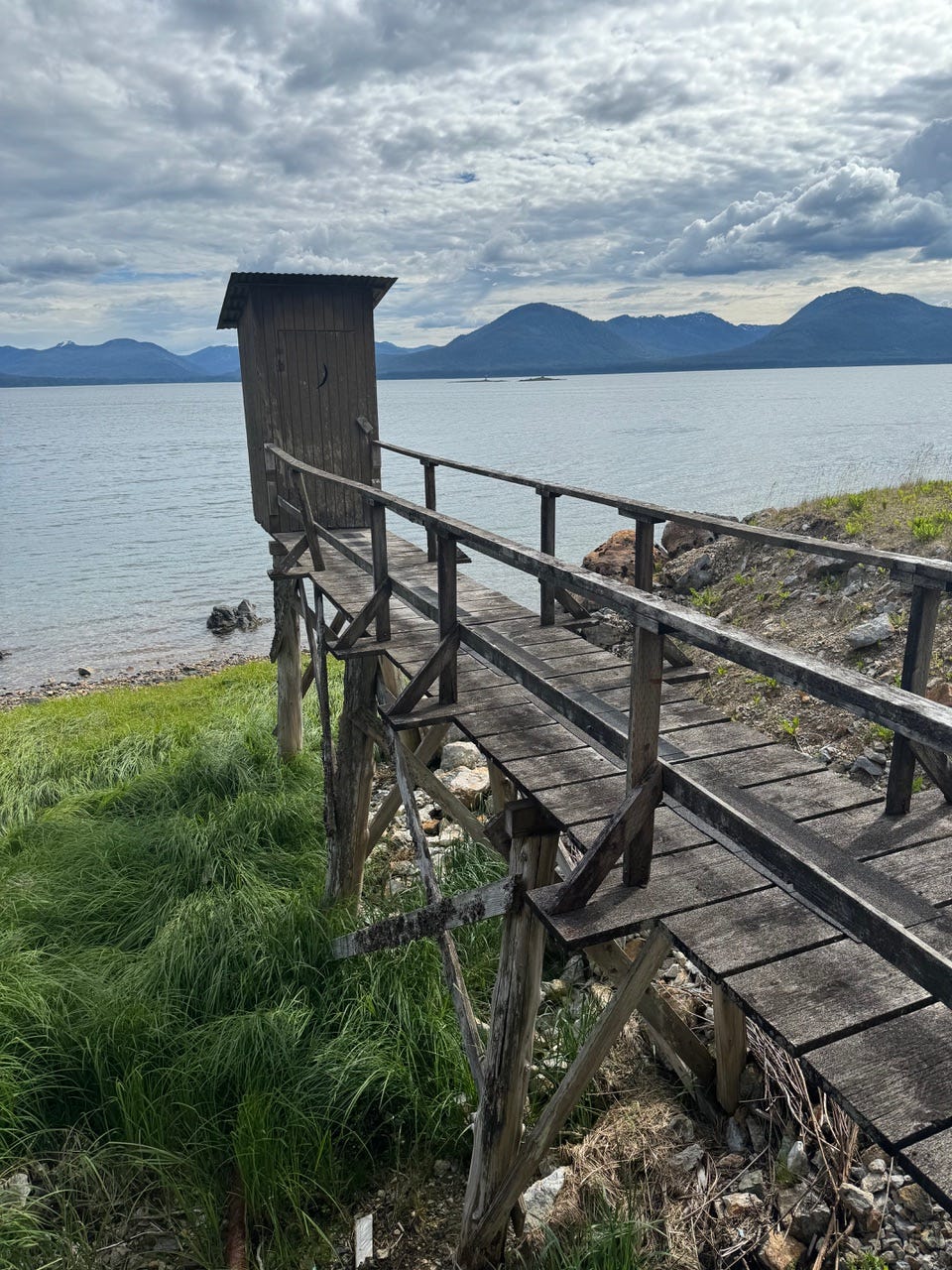
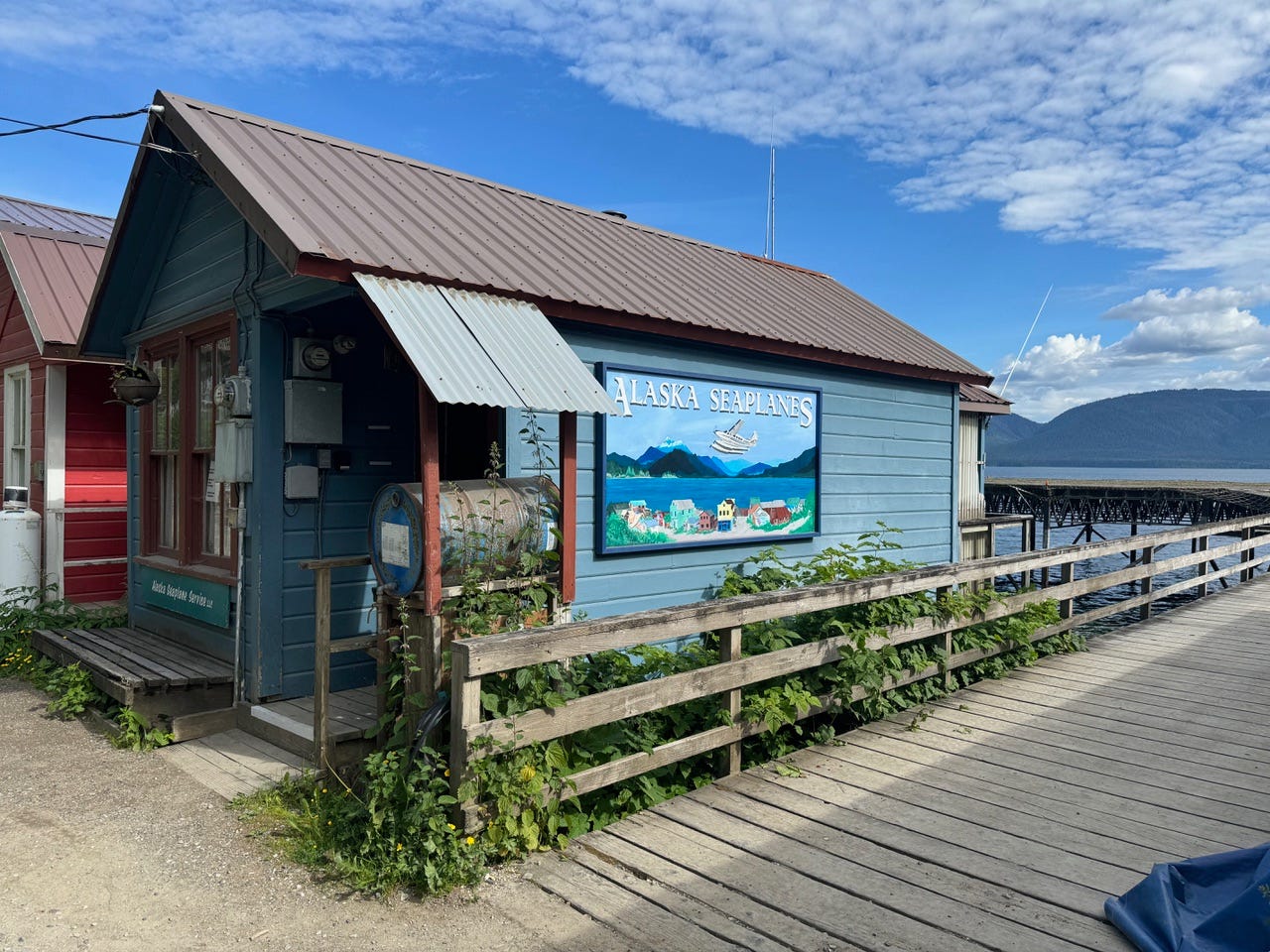
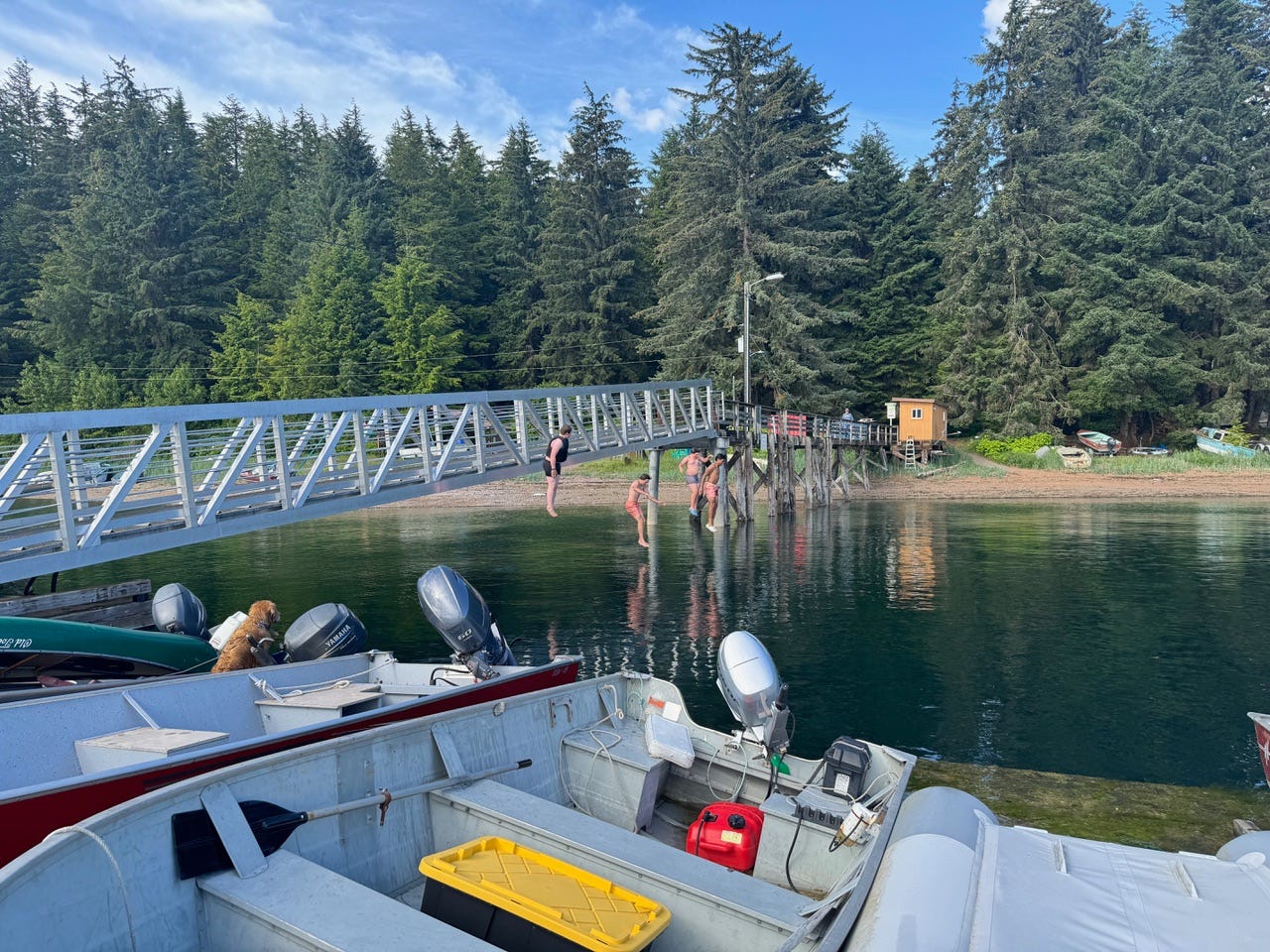
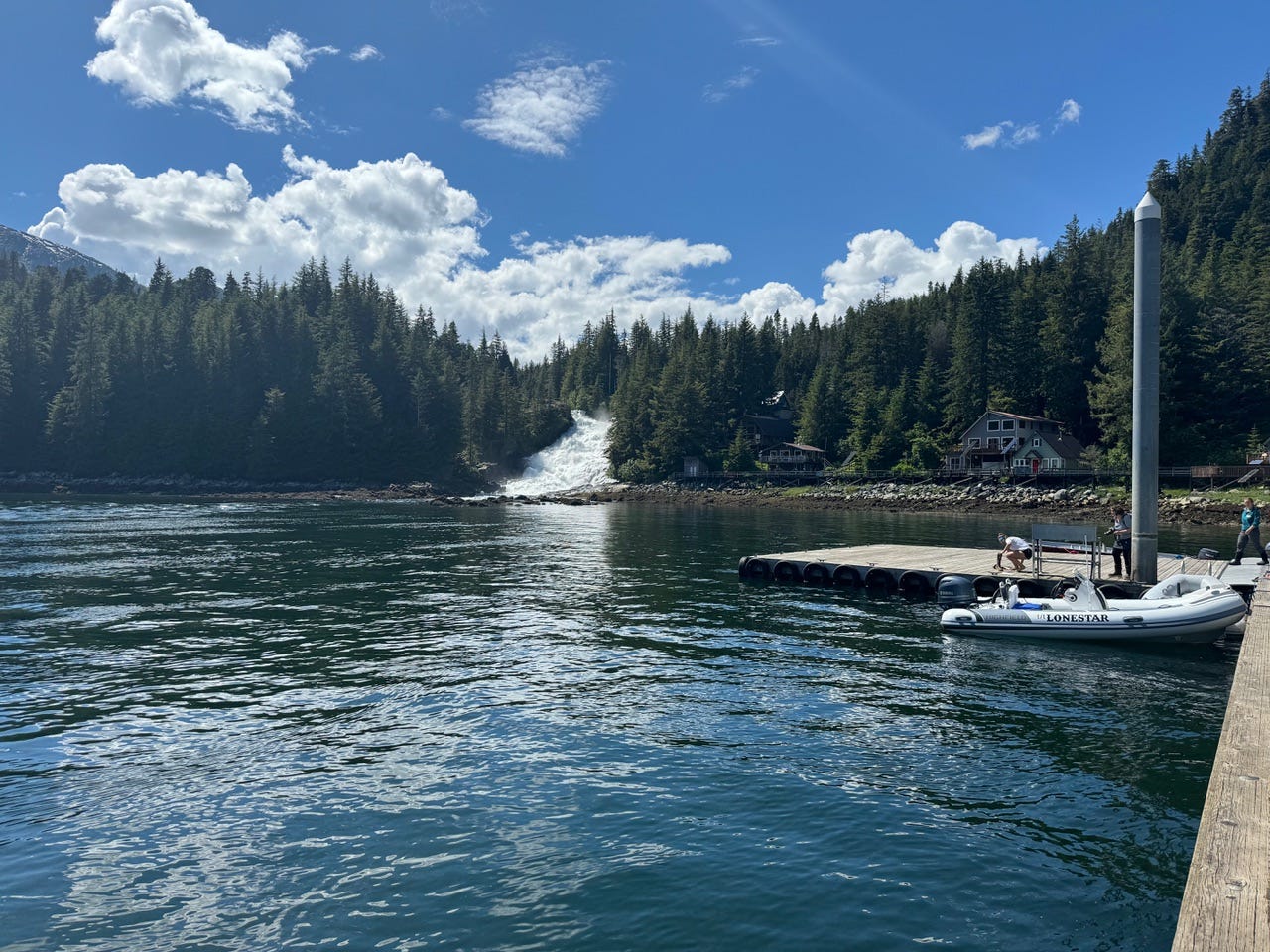
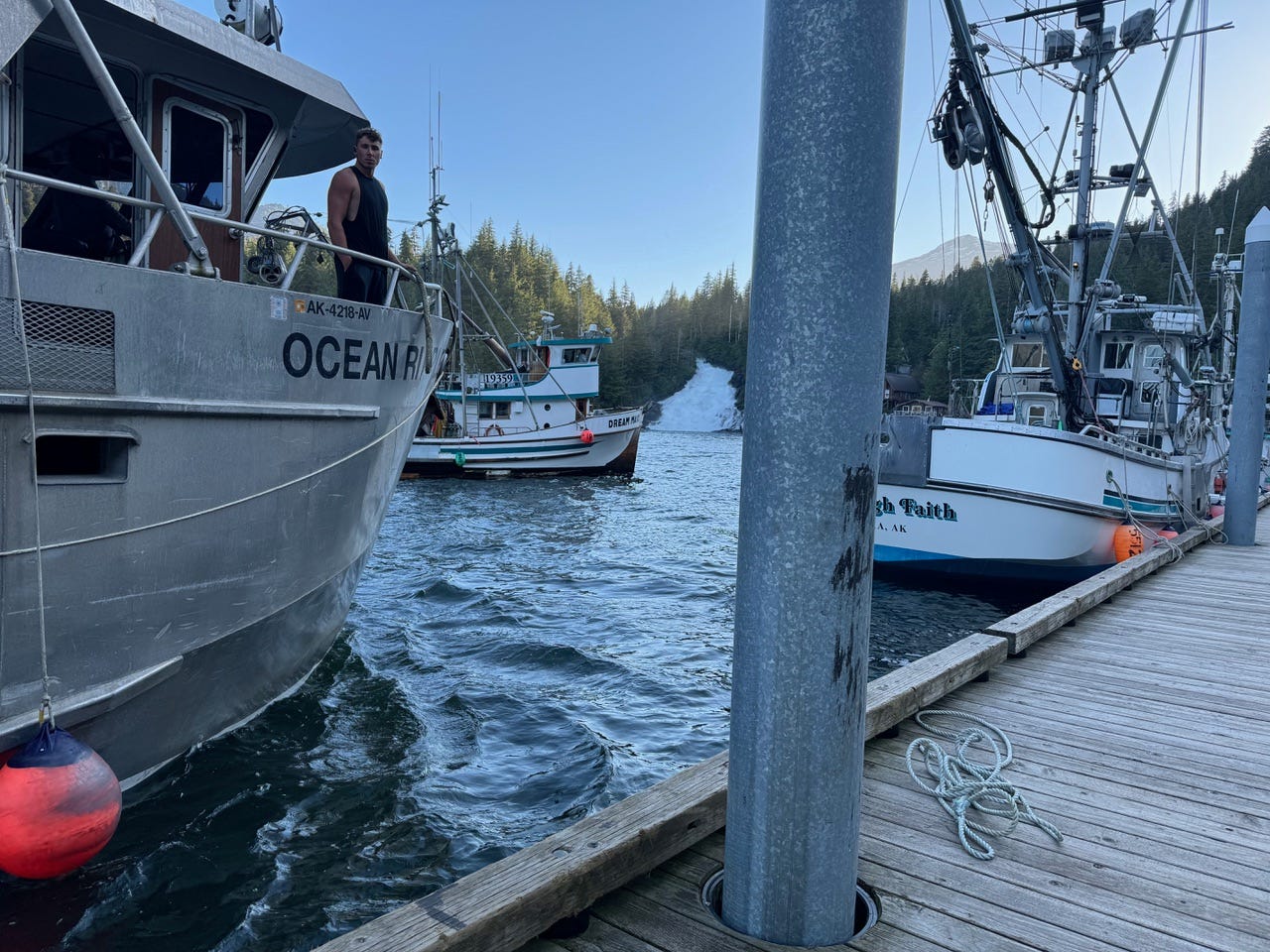

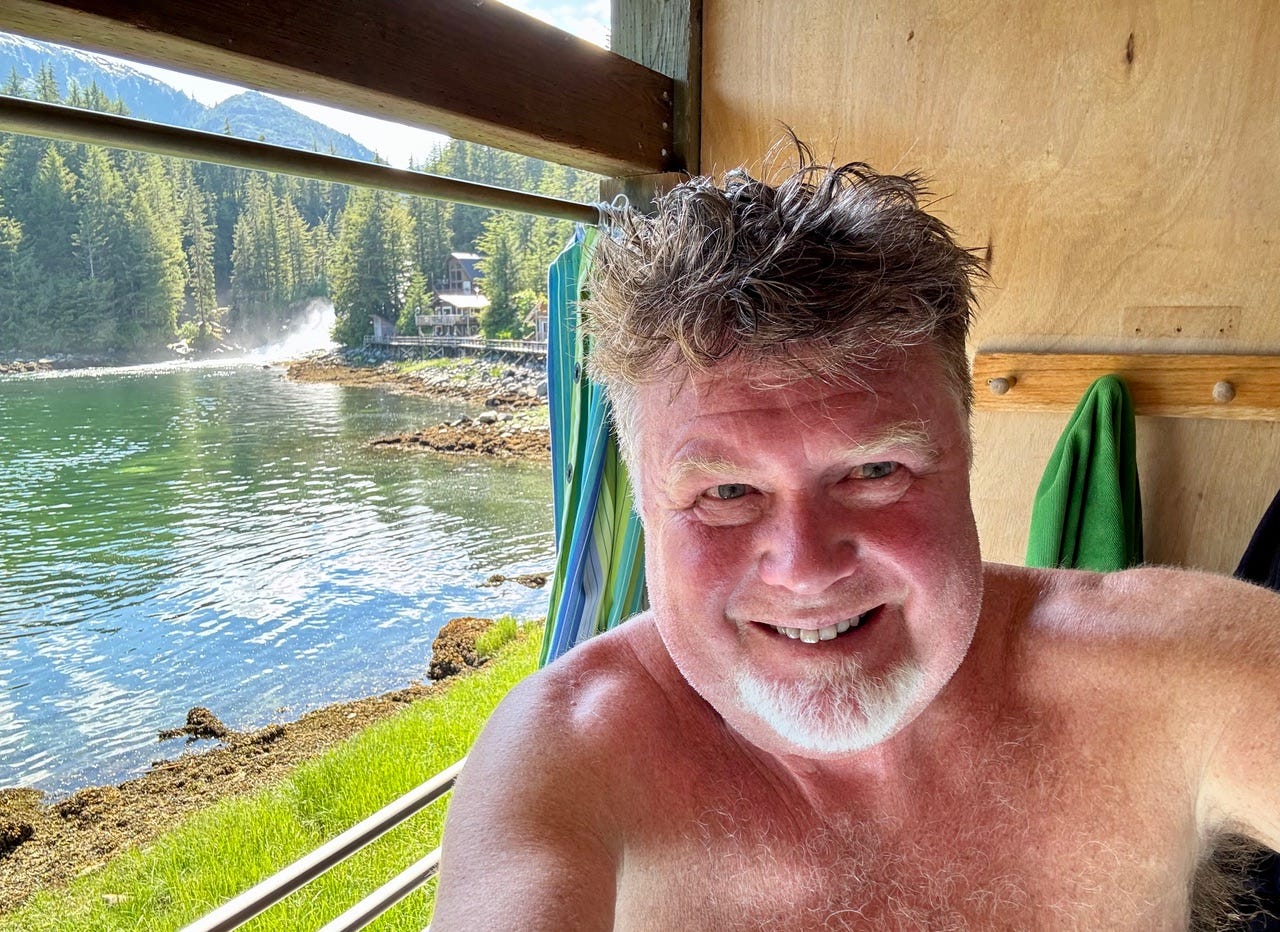
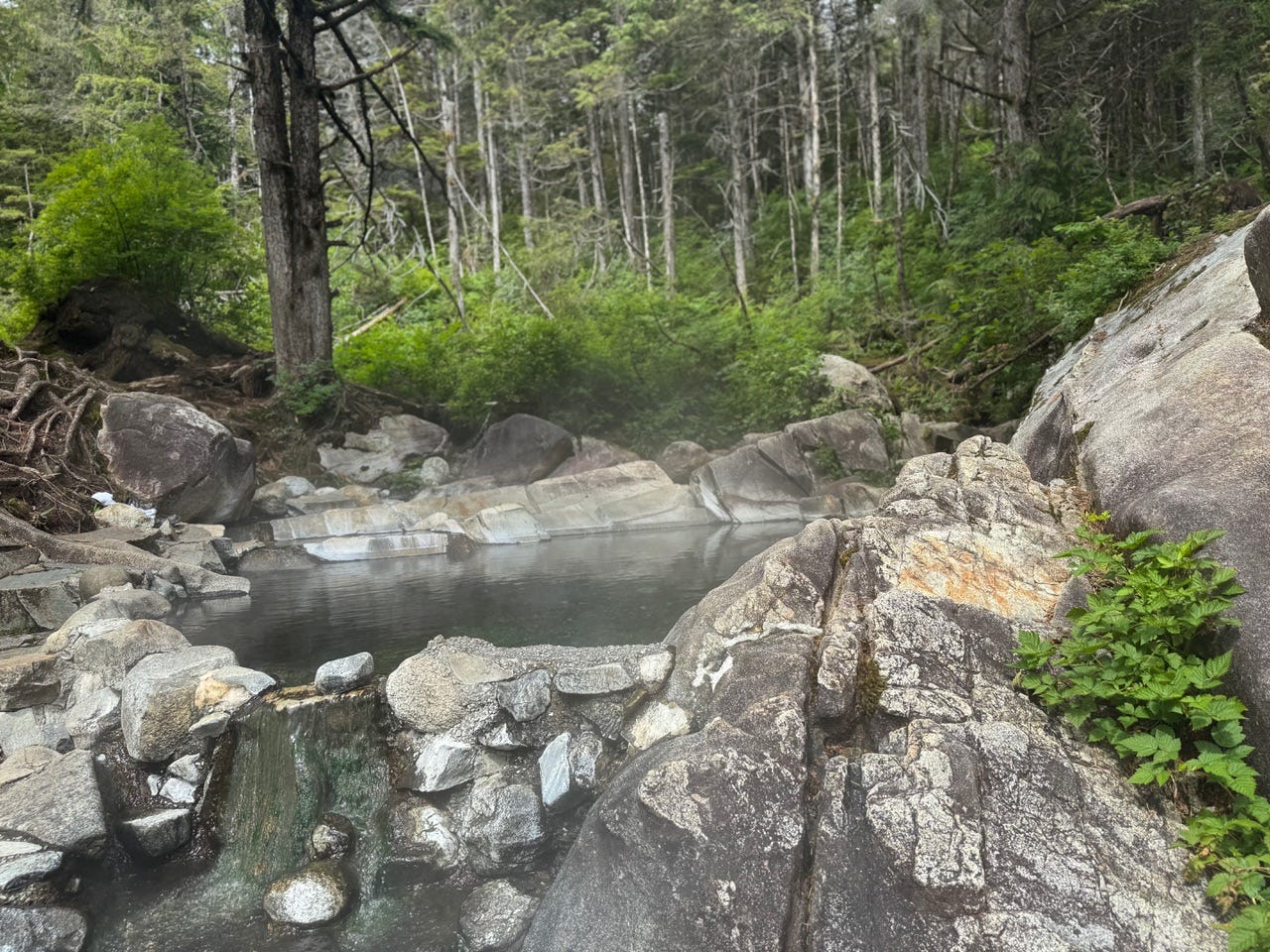
I just got back to Madison wi from attending a wedding in AK, and as we spent time in Seward, I kept thinking about what an amazing trip it would be to spelunk all the various small towns and coves there, whilst cavorting with whales and otters. Sounds pretty dreamy. Retirement!!
Thick Fog? No problem. Just follow Snow Goose, and Bob’s Radar!!!